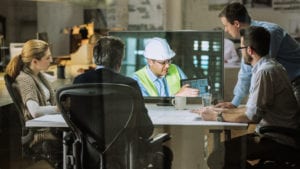Around the world, all kinds of buildings – from offices to hotels to retail spaces – have transitioned to a state of low occupancy, with some nearly empty. For hotels, securing the safety and security of guests and staff are a top priority. But what is next?
We are hearing several questions from our customers and partners:
- How can I make sure my hotel operates efficiently during low occupancy?
- What systems should I adjust during low occupancy?
- How can I make sure my hotel will return properly to normal operations in the future?
- What should I be mindful about when returning to occupied status?
This article offers some answers in the form of best practices on energy efficiency, safety, reliability, and preparedness for returning to occupancy.
Before you begin, we recommend you reach out to your service partner(s), if you have any, to help you complete this work, either remotely or on-site. If you do not have a service partner, this post offers tips on how your own team can get started.
The checklist
- Establish your scope. First, take stock of your major HVAC and building automation assets, including chillers, air handlers, boilers, fan coils, packaged terminal air conditioners (PTACs), rooftop units, boilers, and thermostats. These are the key components with substantial impact on both energy consumption and the building environment. Take stock of your situation by assessing how many of each of these assets you have. Where are they located? Consult an existing list or build a new one.
- Determine your system architecture. Find out which assets are connected to your building management system (BMS) or guest room energy management system (GREM) and which assets are stand-alone, requiring manual control. If, for instance, your hotel or resort building has a BMS that can manage many rooms’ setpoints, it may be a simple matter of adjusting these globally for all rooms. If room controls require local or manual adjustments, you will have to adjust them one-by-one.
- Focus on deep efficiency. Consider the difference between typical low-occupancy setpoints and “deep” low-occupancy setpoints. If you typically adjust to ±5 °F / 2.5°C off the setpoint, you may consider a deeper ±10 °F / 5.5 °C change during a longer period of low occupancy. Also make sure not to inadvertently put rooms or spaces into heating or cooling mode while adjusting to a higher range unoccupied setpoint. An override may be necessary either locally or via a global command. HVAC fans in rooms can also be set to only run at low speeds.
- Assess your ventilation and economizer systems (use of outside air). During low occupancy, venting out particulates and maintaining proper carbon dioxide dilution is still necessary, but you can often ratchet this down if it is not already managed by your building automation system. The wider range of acceptable temperatures means you can also decrease pressurization and use air economizers more frequently. Overall, the idea is to ease off temperature controls to boost energy efficiency. You can consult your building automation service partner for optimal settings.
- Keep humidity in check. Mold and moisture can become a problem if indoor dew points are not properly maintained. If dew points are too low, condensation could form on cold HVAC components and sensitive building materials. Alternatively, if dew points are too high, relative humidity may rise above 80 percent, which falls outside ASHRAE guidelines.
- Address your electrical and storage space. During normal operation, electrical and storage rooms are often kept at comfortable temperatures for the benefit of maintenance workers. But electrical rooms are, in fact, often rated for outdoor operation, meaning they can be set upwards of 100 °F/37 °C and remain within manufacturers’ recommendations. Allowing higher temperatures in electrical rooms can lower demand on electrical infrastructure and save hotel energy consumption during low occupancy. You should, however, maintain typical setpoints in server closets and IT rooms to avoid downtime or damage.
- Adjust fans and freezers. Do not forget your commercial kitchens and other spaces with fans and freezers. These exhaust fans, and the make-up fans that accompany them, are often set to run 24/7 and so continuing to run them will waste energy. And if you no longer need refrigerators or freezers to preserve food, shut them down if there are no products to store.
- Protect your water system. Check to make sure water continues to flow through your pipes. Stagnant water creates a health risk in domestic systems and leads to higher than normal corrosion in non-potable systems. Consult your water services specialist to find the most accurate regulation on minimum water flow. For steam and hot water boilers, consult trained specialists to reduce or shut down boilers, which may not be needed during low occupancy.
- Take advantage of Variable Speed Drives (VSDs). Your hotel’s systems are designed for near full capacity, not low capacity. With a fixed drive motor, your hotel energy consumption will remain constant regardless of its output. Chillers with VSDs and pumps can reduce output by inheriting partial load conditions to lower amperage, thereby saving energy. Note that some VSDs may not be connected to BMS, so you must adjust them manually. To save energy, only run VSD-powered chillers, boilers, and other HVAC components such as single zone air handlers and fan coil units.
- Close Spa/Beauty Salon. Ensure all treatment rooms are properly shut down (heated blankets, stone roasters, hot towel cabbies, etc.). Unplug all work-out equipment and plan to recommission upon return to occupancy.
- Utilize Variable Frequency Drives (VFDs) on pool pumps (if applicable). Set pool at code-allowed minimum circulation rate if a variable frequency drive (VFD) is installed on the pump. If you do not have a VFD, now would be the time to install and work with a local utility on potential incentives. Only consider draining if there are no other options as hydrostatic pressure can cause damage when left empty for long periods of time.
- Decommission jacuzzis. Have them drained, cleaned, and repaired if necessary. Consider new signage with social distancing in mind.
- Reduce number of elevators in operation. Work within code allowances (building department and fire department) and with service provider to shut down the amount of elevator banks in operation to minimize hotel energy consumption while still supporting the needs of a reduced staff.
- Turn off and maintain appliances in Hotels with Restaurants / Bars:
- Shut down all dishwashers and drain / sanitize.
- Shut off kitchen hoods and exhaust fans.
- Properly evacuate soda lines for guns per foodservice guidelines.
- Empty coolers / freezers and properly sanitize, shut down.
- Ensure stove pilot lights are off and gas appliances are off.
- Shut down and drain all steam equipment.
- Consider remodel / reconfiguration of buffet style arrangements to mitigate health concerns (e.g., eliminate self-serve).
- Record your changes so you do not forget them. If you make all these adjustments without keeping track of the typical settings, you may struggle to return your hotel to normal operations. Returning to normal operations while some systems are still set on low-occupancy settings may cause issues with occupant comfort, HVAC performance, and safety.
Going further
These 15 tips are just the basics to drive efficiency during this period of low occupancy. Each hotel has its unique qualities and therefore, opportunities for additional savings. The best way to make sure you do what’s right for your hotel is to work with trained experts in building management. If you face uncertainty about doing this work, our field service engineers can help, whether face-to-face or remotely. For more information, download Efficient Hotels in Unprecedented Times, a 45-point checklist to help you optimize hotel operations during low-occupancy situations, contact your local account representative, or visit our solution page.
Contributor:

Chris Magee, an Account Executive for the hospitality segment, leads the business development efforts with hotel and casino giants—MGM, Caesars, AEG Worldwide—and the tremendous hospitality growth in Las Vegas. He is driving the EcoStruxure for Hotel strategy across all Schneider Electric domains to deliver an enhanced guest experience through digital transformation.
During his 30 years with MGM, most recently as VP of Sustainable Facilities in MGM’s Corporate Sustainability Division, Chris advanced MGM’s long-term energy management strategy while improving efficiency and reducing operating costs at resort facilities. This included evaluating, selecting, and deploying leading-edge efficiency and renewable energy technologies that met business goals and enhanced environmental leadership.
Chris, a nationally recognized expert in energy efficiency and green building performance, continues to sit on or chair many boards and committees, including the U.S. Department of Energy, Better Buildings Alliance – Hospitality sector, and the Conservation District of Southern Nevada. He holds a bachelor’s degree in Communications and Media Studies from the University of Nevada, Las Vegas. In his time outside of work, you will find him at the pool either coaching or playing water polo.



